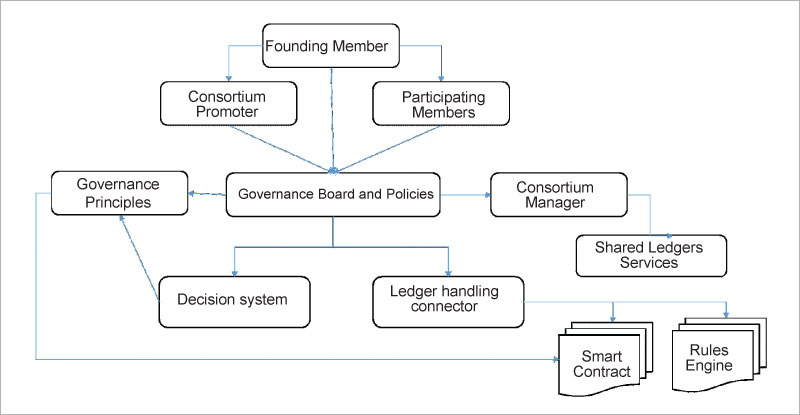A consortium blockchain consists of multiple organisations or nodes working together to maintain a shared blockchain network. Its many benefits are making this blockchain variant pretty popular today.
he blockchain platform is popular for its decentralised nature, tamper-proof transactions and reliability. The reliability in the network is based on the consensus algorithm used in the execution of the platform. There are multiple variants of consensus algorithms that can be used in different types of blockchain platforms like private and public blockchain platforms.
A consortium blockchain is a permissioned blockchain platform. It is a hybrid solution combining the benefits of a private blockchain and public blockchain platform. Hence, it is getting more popular as it bridges the gap between both these platforms.
Importance of consortium blockchain
Blockchain platforms are classified in order of usability as private blockchain, public blockchain, semi-private blockchain and consortium blockchain. In fact, semi-private blockchain is an early version of the hybrid blockchain platform as it offers an enterprise-level public blockchain platform to business users. For example, inventory management in a distributed platform, which connects the manufacturing and supplier units, is grouped together in a semi-private blockchain platform.
The consortium blockchain platform branched from this to provide a hybrid platform combining various blockchain platforms. This kind of architecture is also referred to as a federated blockchain platform as the governance and workflow is distributed in nature. This feature can be expected in private blockchain platforms and not on a public blockchain platform. On the other hand, implementing scalable blockchain nodes in a network is not possible in a private blockchain but can be done in a public blockchain platform.
A consortium blockchain offers a hybrid service combining most of the benefits of private blockchain and public blockchain, which helps address data redundancy issues and reduces transaction costs.
Use cases of consortium blockchain
Consortium blockchains find applications across various industries, benefiting from collaborative efforts while ensuring data security and transparency. Here are several use cases.
- Supply chain management: Consortium blockchain can be used to track the movement of goods and materials through a supply chain. This can help to improve efficiency, transparency, and traceability.
- Trade finance: It can be used to facilitate trade finance transactions. This can help to reduce costs and improve the speed and efficiency of transactions.
- Healthcare: It can be used to store and share medical records. This can help to improve the quality of care.
- Financial services: Secure and transparent financial transactions can be carried out using a consortium blockchain. This can help to reduce fraud and improve efficiency.
- Intellectual property: It can be used to track and manage intellectual property rights. This can help to prevent counterfeiting and improve the efficiency of licensing.
- Regulatory compliance: It can be used to comply with regulations. This can help to reduce the risk of penalties and improve efficiency.
- Government: Government services can improve by using a consortium blockchain. They can become more transparent, efficient, and accountable.
- Energy trading: In the energy sector, producers, consumers, and grid operators can form a consortium to trade energy assets efficiently. Smart contracts on the blockchain automate energy transactions, ensuring transparency and trust.
- Education: Educational institutions can collaborate on a consortium blockchain to verify and share credentials and qualifications. This simplifies the hiring process for employers and reduces credential fraud.
- Shipping and logistics: A consortium of shipping companies and customs authorities can streamline documentation and customs clearance processes. This reduces delays and enhances security in international trade.
- Pharmaceuticals: The pharmaceutical industry can establish a consortium to track the authenticity and quality of drugs, reducing counterfeit products and ensuring patient safety.
These diverse use cases highlight the versatility of consortium blockchains in improving transparency, security, and collaboration across various sectors. They offer opportunities to streamline processes, reduce fraud, and enhance trust among participants in complex ecosystems.

Security and data protection in a consortium blockchain
A consortium blockchain typically consists of multiple organisations or nodes working together to maintain a shared blockchain network. Ensuring the security and protection of data in this context involves the following key aspects.
Cryptography: Blockchain uses cryptography to secure its data. This includes the use of hashing algorithms to create unique fingerprints for each block of data, as well as digital signatures to verify the authenticity of transactions.
Distributed ledger: The data in a blockchain is stored in a distributed ledger, which means that it is not stored in a single location. This makes it more difficult for hackers to access or tamper with the data.
Consensus mechanism: A blockchain uses a consensus mechanism to ensure that all participants in the network agree on the state of the ledger. This helps to prevent fraud and ensure the integrity of the data.
Access control: In a consortium blockchain, access to the network is controlled by a group of authorised participants. This helps to protect the data from unauthorised access.
Encryption: Sensitive data can be encrypted before it is stored on the blockchain. This, too, helps to protect the data from unauthorised access.
Privacy: There are a number of ways to protect the privacy of data on a blockchain. This includes the use of pseudonymous addresses and encryption.
Here are some additional considerations for security and data protection in a consortium blockchain.
The need for a strong governance framework: A well-defined governance framework is essential for ensuring the security and data protection of a consortium blockchain. This framework should define the roles and responsibilities of the participants in the network, as well as the procedures for managing security risks.
The need for regular audits: Regular audits are essential for identifying and addressing security vulnerabilities in a consortium blockchain. These audits should be conducted by independent third parties.
The need for continuous improvement: The security and data protection of a consortium blockchain is an ongoing process. It is important to continuously monitor the network for potential risks and to implement new security measures as needed.

Benefits and challenges of consortium blockchains
Consortium blockchains offer several benefits but face some unique challenges.
Benefits
- Security and transparency: Blockchain is a secure and transparent way to store data. The data is encrypted and distributed across the network, making it difficult to hack or tamper with. The distributed ledger also makes it easy to track the history of transactions, which can help to prevent fraud.
- Collaboration: Consortium blockchains can help to facilitate collaboration between organisations. By sharing data and processes on a shared platform, organisations can work together more efficiently and effectively.Cost savings: Consortium blockchains can help to reduce costs. By sharing resources and infrastructure, organisations can save money on development, maintenance, and operation costs.
- Scalability: These blockchains can be scaled to handle a large number of transactions. This makes them a good fit for applications that require high throughput, such as supply chain management and trade finance.
Challenges
- Governance: Consortium blockchains require a well-defined governance framework to ensure that all participants agree on the rules and procedures for the network. This can be a challenge, especially if the consortium includes organisations with different interests.
- Complexity: These blockchains can be complex to implement and manage. This is because they require a high level of technical expertise and coordination between the participants.
- Regulation: The regulatory landscape for blockchains is still evolving. This can make it difficult for organisations to comply with all applicable regulations.
- Lack of standards: There are no universally accepted standards for consortium blockchains. This can make it difficult for organisations to interoperate with each other.
Overall, consortium blockchains offer a number of benefits, but they also come with some challenges. The decision of whether or not to use a consortium blockchain should be made on a case-by-case basis, taking into account the specific needs of the organisation.
Consortium blockchain governance
The functional architecture of any blockchain platform, which helps to define the governance model, is based on various consensus algorithms used for platform execution. These are listed here.
Proof of work (PoW): This is the original consensus algorithm from Satoshi Nakamoto’s first research on blockchain, and is used as a mechanism to confirm the transaction has been completed. If confirmed, a new block gets added to the chain of networks. This helps prevent distributed denial of service (DDoS) network attacks.
Proof of stake (PoS): PoS involves a lot of system resources like GPUs. Hence, it is an advanced mechanism suitable for sophisticated blockchain networks. PoS addresses the challenge of high resource usage by using an algorithm based on distributed tokens and static coin supply.
Delegated proof of stake (DPoS): This is an extended version of PoS. PoS is like a lottery mechanism based on the coin stake of the users, while DPoS influences all stakeholders in the network equally.
Consortium blockchains have become popular in the last few years. They are widely preferred as a solution to replace legacy distributed workflow systems like simplified document management systems or semi-manual compliance systems.
Typically, in a consortium blockchain, we have various key entities (Figure 2) as explained below.
- The founding member develops the governance model and hierarchy of groups to be used in the blockchain platform.
- The consortium promoter addresses the administrative activity for implementing the blockchain platform of choice — R3, Hyperledger, B3i, Bankchain, etc — depending on the industrial solution and use case being addressed.
- The participating members are the actual users of the blockchain platform. They handle the transactions and prepare the interconnection between nodes in the blockchain platform.
- Governance principles define the rules to be used between public and private blockchain solutions for implementation in the architecture.
- Governance board is the central authority that handles architecture decisions based on the justification from the consortium promoter, participating member and founding member.
- Consortium manager decides how the rules engine and the smart contracts are to be used in the blockchain to address key transactional requirements.
- Decision system helps to choose the responsibility to be handled by different governing bodies in the consortium blockchain units.
- Ledger handling connectors help to connect to the shared ledger service or cross-platform services when using a combination of public and private blockchain platforms.
- Rules engine defines the set of rules to be used for transaction handling and the business logic to be used for the blockchain execution workflow.
- Smart contract is defined by the PoW or PoS consensus algorithms. It looks at how to handle the trustless entities in the blockchain platform.
Overall, the consortium blockchain governance model is designed to work as a permissioned ledger for a group of consortium promoters based on a decision system. This makes the blockchain behave as a multi-party consensus platform, where every transaction and operation is verified by a special group of pre-approved nodes, and every node is not allowed to grant special approval.












































































